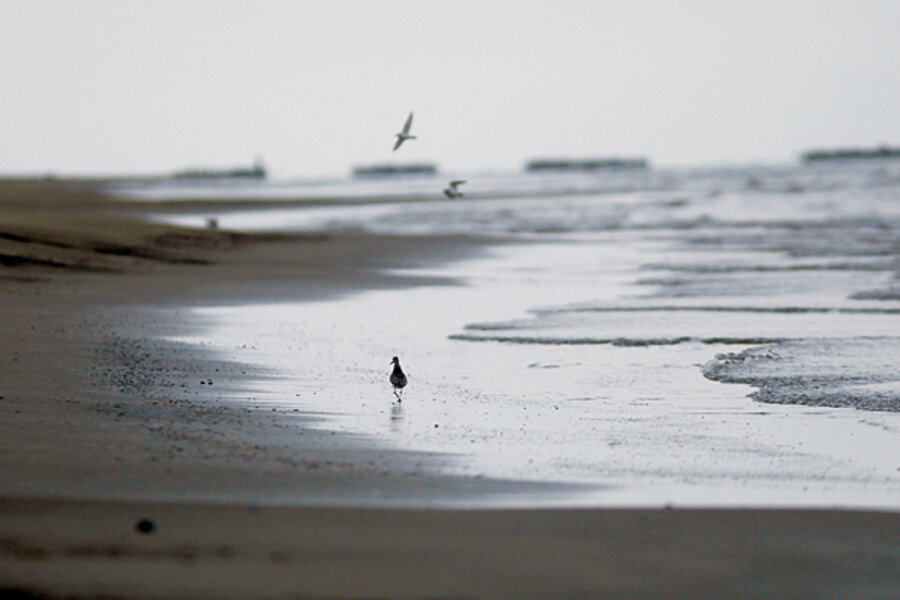Gulf oil spill: After it hit beaches, where did it go?
Loading...
| Grand Isle, La.
On a morning stroll down the serene beaches of Grand Isle State Park, a visitor can watch as waves quietly lap the shore, birds sail overhead, a porpoise pokes above the water.
Yet it takes only minutes of digging into the sand to reveal a menace that experts say permanently threatens this picturesque landscape: pools of crude oil lurking less than a foot below the surface.
The April 20 explosion of an oil rig in the Gulf of Mexico released an estimated 205 million gallons of oil into these waters. It remains unclear how much oil was actually recovered, how much remains, and – most important for the fragile coastal ecosystems – where it ended up.
A report published in August by the National Oceanic and Atmospheric Administration (NOAA) concluded that 74 percent of the oil has been recovered, evaporated, or naturally dispersed, leaving a residual 26 percent “on or just below the surface” of water or in sand. But many scientists question the validity of that report, saying that, due to the unprecedented scope of the spill and the record volume of dispersants used to mitigate its impact, it is too soon to make any determination about where or when the oil landed.
Recently, NOAA itself has indicated that the report is a work in progress.
Ron Kendall, director of The Institute of Environmental and Human Health at Texas Tech University in Lubbock and a member of the assessment team for the Exxon Valdez spill in 1989, says it will take “extensive environmental sampling” over a period of years to determine how much oil is embedded into coastal habitats, and where.
Oil that remains trapped under a marsh or buried beneath a beach is particularly threatening because the lack of oxygen will prevent bacteria from breaking down the oil, meaning “it will be there for all time,” says Nancy Kinner, codirector of The Coastal Response Research Center at the University of New Hampshire in Durham. Twenty-one years after the Valdez spill, oil remains submerged in the beaches of Prince William Sound in Alaska.
The same is true in Massachusetts’ Buzzards Bay, where a 1969 spill released 175,000 gallons of diesel fuel; 41 years later, sampling shows oil three to eight inches below the land’s surface.
When oil gets buried that deep, says Ms. Kinner, it creates a “trade-off” to mitigate, especially when it involves a fragile habitat, like the coastal wetlands, whose survival is already threatened.
“Is it better to leave it there than to dig up the whole marsh? Because when you dig up the whole marsh, you do a tremendous amount of damage. You’ll never get the marsh back,” she says.
The risks of having oil hidden so deep below the surface are numerous. Among them: Drinking water is degraded; the food chain is affected because organisms like mussels and crustaceans are threatened; and animals such as sea turtles have no place to bury their eggs.
Oil that makes its home below sand is also vulnerable to seasonal storms, which means it is potentially mobile and can represent “a new release of oil into the environment” when it returns to the freshwater table, Kinner says.
Frank Galgano, chair of the geography and environment department at Villanova University near Philadelphia, says oil embedded in the ocean floor is much more stationary because of the sheer depth and the frigid temperatures, but coastal oil “is just not going to sit there.” The hydraulics particular to each coastal system can potentially shift the oil to deeper layers in the sediment. “That’s the most insidious part of that oil that’s trapped. Eventually, over many years, it’ll seep lower and lower into the system,” he says.
One way being developed to quickly degrade trapped oil is biomediation, in which oxygen is injected into the sand through trenches or spraying. Michel Boufadel, chair of the department of civil and environmental engineering at Temple University in Philadelphia, is working with NOAA to implement the technique. He says past cleanup efforts “looked at the beach like a box” and ignored the fact that it is a continually moving organism that needs to be treated according to its particular characteristics.
So far, NOAA’s directives for Gulf Coast beach cleanup include cosmetically washing surface contamination, collecting tar balls, and removing the top layers of certain areas where oil is concentrated.
John Tarpley, chief scientific support coordinator for NOAA, says the agency’s goal is to clean beaches so they have “1 percent of oil or less.” Highly trafficked public beaches are a priority, he adds. However, environmentalists warn that the departure of cleanup crews will not mean the beaches have a clean bill of health.
“They will never clean it all up,’’ says Doug Inkley, a senior scientist for the National Wildlife Federation. “It is impossible to remove all the oil from the environment. That cannot be done.”






